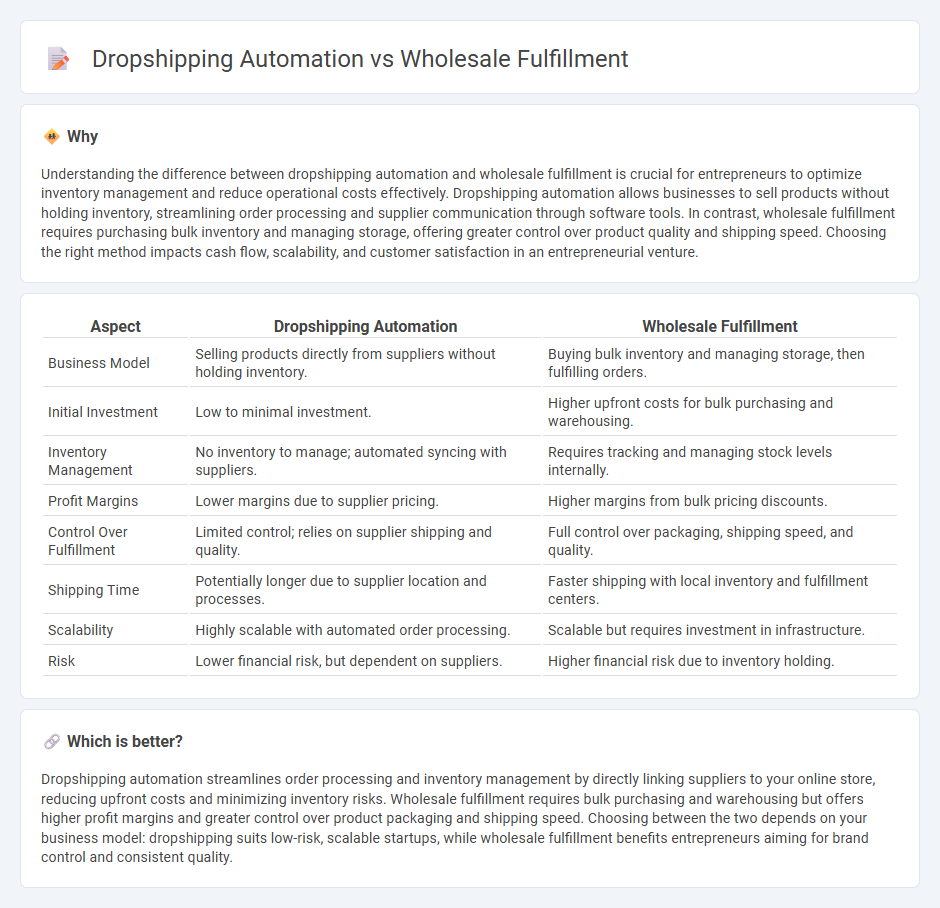
Dropshipping automation streamlines order processing by directly connecting suppliers with customers, eliminating inventory management and reducing upfront costs. Wholesale fulfillment requires purchasing bulk products, storing inventory, and handling shipping logistics, which can lead to higher control but increased operational complexity. Explore the key differences between dropshipping automation and wholesale fulfillment to determine the best strategy for your entrepreneurial venture.
Why it is important
Understanding the difference between dropshipping automation and wholesale fulfillment is crucial for entrepreneurs to optimize inventory management and reduce operational costs effectively. Dropshipping automation allows businesses to sell products without holding inventory, streamlining order processing and supplier communication through software tools. In contrast, wholesale fulfillment requires purchasing bulk inventory and managing storage, offering greater control over product quality and shipping speed. Choosing the right method impacts cash flow, scalability, and customer satisfaction in an entrepreneurial venture.
Comparison Table
| Aspect | Dropshipping Automation | Wholesale Fulfillment |
|---|---|---|
| Business Model | Selling products directly from suppliers without holding inventory. | Buying bulk inventory and managing storage, then fulfilling orders. |
| Initial Investment | Low to minimal investment. | Higher upfront costs for bulk purchasing and warehousing. |
| Inventory Management | No inventory to manage; automated syncing with suppliers. | Requires tracking and managing stock levels internally. |
| Profit Margins | Lower margins due to supplier pricing. | Higher margins from bulk pricing discounts. |
| Control Over Fulfillment | Limited control; relies on supplier shipping and quality. | Full control over packaging, shipping speed, and quality. |
| Shipping Time | Potentially longer due to supplier location and processes. | Faster shipping with local inventory and fulfillment centers. |
| Scalability | Highly scalable with automated order processing. | Scalable but requires investment in infrastructure. |
| Risk | Lower financial risk, but dependent on suppliers. | Higher financial risk due to inventory holding. |
Which is better?
Dropshipping automation streamlines order processing and inventory management by directly linking suppliers to your online store, reducing upfront costs and minimizing inventory risks. Wholesale fulfillment requires bulk purchasing and warehousing but offers higher profit margins and greater control over product packaging and shipping speed. Choosing between the two depends on your business model: dropshipping suits low-risk, scalable startups, while wholesale fulfillment benefits entrepreneurs aiming for brand control and consistent quality.
Connection
Dropshipping automation streamlines order processing by integrating with wholesale fulfillment systems, enabling real-time inventory updates and faster shipping. Wholesale fulfillment provides bulk products at lower costs, allowing dropshipping entrepreneurs to scale operations without holding stock. Combining these methods optimizes supply chain efficiency and boosts profit margins in e-commerce businesses.
Key Terms
Inventory Management
Wholesale fulfillment automates inventory management by centralizing stock control, enabling real-time tracking and efficient order processing, which reduces the risk of overselling. Dropshipping automation relies on supplier inventory updates, often causing delays or discrepancies in inventory data. Explore how optimizing inventory management can enhance your wholesale fulfillment or dropshipping strategy.
Order Processing
Wholesale fulfillment automates order processing by consolidating inventory storage, packaging, and shipping, enabling faster and more accurate order dispatch compared to manual methods. Dropshipping automation connects directly with supplier systems to streamline order forwarding and tracking, eliminating inventory management but sometimes increasing fulfillment times. Explore the key differences and benefits between these automation methods to optimize your e-commerce operations.
Supplier Integration
Wholesale fulfillment streamlines inventory management by allowing retailers to purchase products in bulk directly from suppliers, ensuring faster order processing and greater control over stock levels. Dropshipping automation relies on seamless supplier integration to automatically transmit customer orders to suppliers, who then ship products directly to consumers, reducing inventory risks and upfront costs. Explore deeper into how supplier integration enhances both wholesale fulfillment and dropshipping automation strategies.
Source and External Links
Wholesale Fulfillment | Ryder Fulfillment Solutions - Wholesale fulfillment serves businesses placing large, infrequent orders by focusing on efficiency, scalability, and cost-effectiveness to optimize supply chain operations and provide value-added services including inventory management, order fulfillment, and transportation.
Wholesale Fulfillment - Wineshipping.com - Wineshipping offers wholesale fulfillment with an emphasis on order precision, temperature-controlled storage, and cost optimization by consolidating storage and shipping to improve margins and streamline distribution.
B2B Fulfillment Services - Cart.com - Cart.com provides omnichannel wholesale fulfillment with automated distribution, efficient bulk order handling, and last-mile delivery services designed to support complex multi-channel operations and retail fulfillment needs.
 dowidth.com
dowidth.com